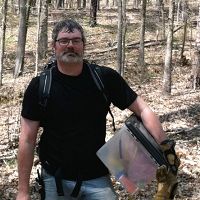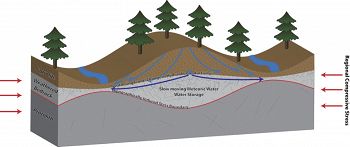Holbrook, 2016
Critical zone architecture and processes: a geophysical perspective
Holbrook, W. Steven (2016)
American Geophysical Union 2016 Fall Meeting, San Francisco, CA Cross-CZO National
-
Boulder, Calhoun, Eel, Reynolds, Sierra, COLLABORATOR
Abstract
The “critical zone (CZ),” Earth’s near-surface layer that reaches from treetop to bedrock, sustains terrestrial life by storing water and producing nutrients. Despite is central importance, however, the CZ remains poorly understood, due in part to the complexity of interacting biogeochemical and physical processes that take place there, and in part due to the difficulty of measuring CZ properties and processes at depth. Major outstanding questions include: What is the architecture of the CZ? How does that architecture vary across scales and across gradients in climate, lithology, topography, biology and regional states of stress? What processes control the architecture of the CZ? At what depth does weathering initiate, and what controls the rates at which it proceeds? Based on recent geophysical campaigns at seven Critical Zone Observatory (CZO) sites and several other locations, a geophysical perspective on CZ architecture and processes is emerging. CZ architecture can be usefully divided into four layers, each of which has distinct geophysical properties: soil, saprolite, weathered bedrock and protolith. The distribution of those layers across landscapes varies depending on protolith composition and internal structure, topography, climate (P/T) and the regional state of stress. Combined observations from deep CZ drilling, geophysics and geochemistry demonstrate that chemical weathering initiates deep in the CZ, in concert with mechanical weathering (fracturing), as chemical weathering appears concentrated along fractures in borehole walls. At the Calhoun CZO, the plagioclase weathering front occurs at nearly 40 m depth, at the base of a ~25-m-thick layer of weathered bedrock. The principal boundary in porosity, however, occurs at the saprolite/weathered bedrock boundary: porosity decreases over an order of magnitude, from ~50% to ~5% over an 8-m-thick zone at the base of saprolite. Porosity in weathered bedrock is between 2-5%. Future progress will depend on (1) more tightly linked geophysical, geochemical, hydrological and drilling studies, (2) 3D and 4D studies of deep CZ structure, and (3) measurements at multiple scales in the CZ, from pores to plots to hillslopes to catchments.
Citation
Holbrook, W. Steven (2016): Critical zone architecture and processes: a geophysical perspective. American Geophysical Union 2016 Fall Meeting, San Francisco, CA.
 This Paper/Book acknowledges NSF CZO grant support.
This Paper/Book acknowledges NSF CZO grant support.
Explore Further


